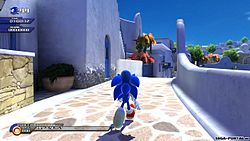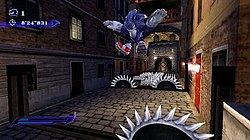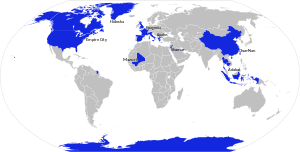Sonic Unleashed
The Werehog gameplay was conceived to help introduce newer gamers unfamiliar with the Sonic franchise to the series and is what influenced the use of Unleashed as a subtitle for western markets.
The game's existence was first brought to light when Sega trademarked the Unleashed name in March 2008, and shortly after, images and a gameplay video were leaked.
[9] In contrast, the PlayStation 2 and Wii versions of the game represent available Boost using bars, which may be added by performing "Action Chains", destroying multiple enemies in quick succession through the use of homing attacks, or by collecting rings.
As the Werehog, the player can cling to distant objects, move items around and perform combo attacks to defeat enemies and advance through the level.
[13] Collecting rings replenishes the Werehog's health,[7] while a special move, Unleashed Mode, allows him to channel his energy into increasing the power of his attacks for a short time.
In addition to these two gameplay types, Sonic Unleashed also features hub worlds, in which the player may reveal, as well as advance, the story of the game.
[13] Hub worlds operate differently depending on the version of the game being played; the PlayStation 3 and Xbox 360 versions feature fully interactive, explorable 3D hub worlds, similar to those in Sonic the Hedgehog and Sonic Adventure, in which townspeople may be interacted with and side quests may be undertaken, in order to gain experience or unlock items, such as artwork, videos and music tracks.
The medals are used to open up doors in the Gaia Gates, which allow players access to puzzle rooms where they can earn bonus content.
[16][17] In addition, the process has the unforeseen side-effect of transforming Sonic into a "Werehog"—a wolf beast form that loses speed but gains greater strength and abilities—at night.
Chip saves Sonic by throwing him to the surface, before returning himself to the inside of the planet; he leaves behind his necklace and some parting words.
Sonic places the necklace on his hand as a bracelet to remind him of their adventure together before speeding off with Tails, flying alongside him on the coastline in the Tornado plane.
[34] Director Yoshihisa Hashimoto felt from the outset that there would be both praise and criticism, but hoped that long-term Sonic fans would understand and empathise with the ideas and direction the team had taken.
[41] Hashimoto, who had never directed a Sonic game before,[32] incorporated new features such as a "Quick Step" mechanic allowing players to dodge obstacles with the left and right bumpers.
[38][42] Hashimoto sought to combine the best qualities of 2D and 3D Sonic gameplay[32][38] and address the criticisms directed at previous 3D entries in the franchise.
Additional code to dynamically adjust the speed of the game for different situations was used to properly balance its fast pace with traditional platforming elements.
[59] A short animated film was released online to tie in with the game on November 17, 2008, titled Sonic: Night of the Werehog,[d] produced by Marza.
[60] In addition to its online release, the short was shown for free at nine selected theaters in Japan for three weeks starting on December 20, 2008, in collaboration with T-Joy Corporation.
[1][65] The mobile version of Sonic Unleashed is strictly a side-scroller reminiscent of the original Genesis games, featuring new level designs and character abilities.
[74] The vocal theme track, "Endless Possibility", written by longtime Sonic game composer Tomoya Ohtani, features Jaret Reddick of the American rock band Bowling for Soup.
[75] The ending theme music for the game is a slow tempo ballad, "Dear My Friend", and features singer Brent Cash.
[citation needed] Initial anticipation when the first media for Unleashed was revealed was high, as the demonstration videos hinted at a possible return of Sonic to his traditional platforming roots, especially because of the series' declining quality in recent years,[95] and a number of poorly received games in the franchise that preceded it, such as the 2006 game, Sonic the Hedgehog.
[77][76][78][79] The added element of motion controls for the Werehog sections, as well as text-based hub worlds and better Werehog level design and camera system, were reasons cited for the higher review scores for the Wii and PlayStation 2 versions of the game,[5][83] though a few review websites, such as 1UP, gave the Wii version a lower score than its Xbox 360 and PlayStation 3 counterparts.
[14] Praise was given to the technical competence of Sega's new Hedgehog Engine as a whole on the Xbox 360 and PlayStation 3 versions, with "bright cartoonish graphics that fly by without a stutter";[83] however, some complaints were raised about frame rate reduction when large numbers of enemies appeared during the Werehog sections.
[7] A generally negative reaction was given by critics to the Werehog concept and corresponding night-time sections, which contributed greatly to the lower than expected review scores.
[80] Further to the change of pace, the new style of gameplay that accompanies the night-time levels was widely criticized, involving "frustrating" platform elements[83] and combat described as not "terribly interesting"[99] and "boring",[83] with "awkward" action sequences overall.
The quests that players must undertake in hub-towns were described as "inane"[80] and "tedious",[83] where "figuring out what happens next involves aimlessly wandering through towns and speaking to citizens, only to discover that most of them don't know what we're looking for".
[97] The story and overall tone of the game, including the new character Chip, were criticised,[97] some remarking that it was too juvenile,[7] or comparable to that of a Saturday morning cartoon.
[105][106] The home console/PC versions of Sonic Generations contain remakes of the "Rooftop Run" stage and the Egg Dragoon boss fight.



